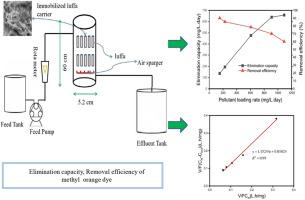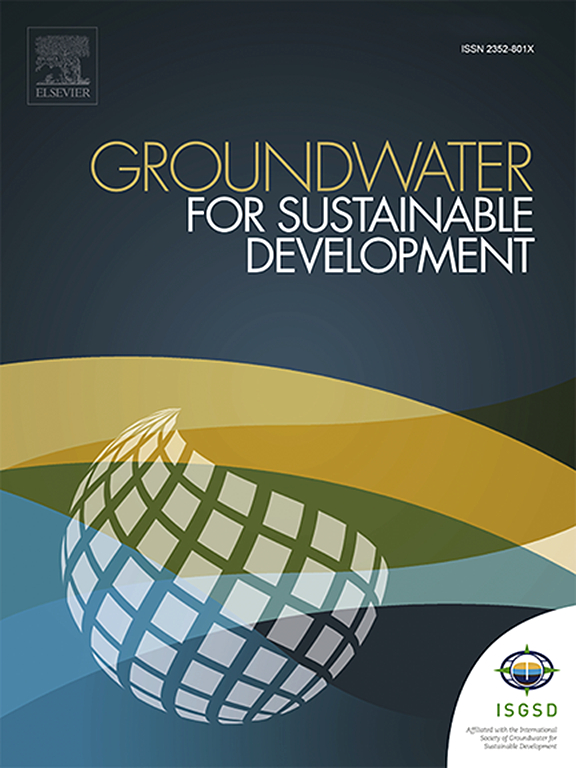固定化丝瓜嗜麦芽霉单胞菌生物降解甲基橙染料的生物反应器性能研究和动力学研究:一种可持续的方法
IF 4.9
Q2 ENGINEERING, ENVIRONMENTAL
引用次数: 0
摘要
在生物膜反应器中使用低成本填料--固定化嗜麦芽糖单胞菌(HE963840.1),对甲基橙染料的生物降解进行了研究。这些细菌是从北方邦马图拉 IOCL 炼油厂普通污水处理厂收集的污泥中分离出来的。使用 16rRNA 对细菌进行了表征。在 30 ± 5 °C 的温度下对反应器的性能进行了为期 30 天的研究。反应器的流速分别为 60 mL/h、90 mL/h、240 mL/h、360 mL/h 和 432 mL/h。研究期间,污染物负荷范围为 151.6 毫克/(升-天)至 1091 毫克/(升-天),染料溶液的 pH 值保持在 7.0 ± 0.4。稳定状态下的最大去除率(RE)和消除能力(EC)分别为 90.2 % 和 658.1 毫克/(升-天)。甲基橙染料的利用率由改进的秸秆-金卡农模型描述,动力学参数--最大利用率(Umax)和饱和常数(KB)分别为 2.70 克/(升-天)和 2.34 克/(升-天)。毒性研究证实了生物降解产物的无毒性。本文章由计算机程序翻译,如有差异,请以英文原文为准。

Performance study of the bioreactor for the biodegradation of methyl orange dye by luffa immobilized Stenotrophomonas maltophilia and kinetic studies: A sustainable approach
The biodegradation of methyl orange dye was examined in a biofilm reactor with luffa immobilized Stenotrophomonas maltophilia ((HE963840.1), low-cost packing material. The bacteria were isolated from the sludge collected from a common effluent treatment plant at IOCL refinery Mathura, Uttar Pradesh. The bacteria were characterized using 16rRNA. The reactor performance was studied at 30 ± 5 °C temperatures over a period of thirty days. The reactor was operated with the flow rates of 60 mL/h, 90 mL/h, 240 mL/h, 360 mL/h and 432 mL/h. The pollutant load ranges from 151.6 mg/(L-day) to 1091 mg/(L-day) and the pH of the dye solution was maintained at 7.0 ± 0.4 during the study. The maximum removal efficiency (RE) and elimination capacity (EC) at steady state were determined as 90.2 % and 658.1 mg/(L-day) respectively. The rate of utilization of the methyl orange dye is described by modified stover-kincannon model with kinetic parameters-maximum utilization rate (Umax) and saturation constant (KB) to be 2.70 g/(L-day) and 2.34 g/(L-day) respectively. The toxicity studies confirm the non-toxic nature of the biodegraded products.
求助全文
通过发布文献求助,成功后即可免费获取论文全文。
去求助
来源期刊

Groundwater for Sustainable Development
Social Sciences-Geography, Planning and Development
CiteScore
11.50
自引率
10.20%
发文量
152
期刊介绍:
Groundwater for Sustainable Development is directed to different stakeholders and professionals, including government and non-governmental organizations, international funding agencies, universities, public water institutions, public health and other public/private sector professionals, and other relevant institutions. It is aimed at professionals, academics and students in the fields of disciplines such as: groundwater and its connection to surface hydrology and environment, soil sciences, engineering, ecology, microbiology, atmospheric sciences, analytical chemistry, hydro-engineering, water technology, environmental ethics, economics, public health, policy, as well as social sciences, legal disciplines, or any other area connected with water issues. The objectives of this journal are to facilitate: • The improvement of effective and sustainable management of water resources across the globe. • The improvement of human access to groundwater resources in adequate quantity and good quality. • The meeting of the increasing demand for drinking and irrigation water needed for food security to contribute to a social and economically sound human development. • The creation of a global inter- and multidisciplinary platform and forum to improve our understanding of groundwater resources and to advocate their effective and sustainable management and protection against contamination. • Interdisciplinary information exchange and to stimulate scientific research in the fields of groundwater related sciences and social and health sciences required to achieve the United Nations Millennium Development Goals for sustainable development.
 求助内容:
求助内容: 应助结果提醒方式:
应助结果提醒方式:


